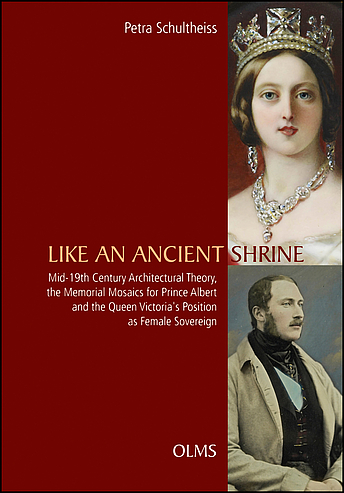Schultheiss
Like an Ancient Shrine
ISBN 978-3-487-15540-1
When Prince Albert died in 1861 at the age of forty-two, his wife Queen Victoria followed this tragic event by an elaborate mourning period in which she surrounded herself as well as her people with memorials of the Prince Consort. Of these, the three most elaborate, the Albert Memorial Chapel, the Royal Mausoleum and the National Memorial to the Prince Consort, all included mosaic decoration. In close connection to current architectural theories such as polychromy or the ideal of the complete decoration as well as the research and experimentation that was carried out with and about the medium mosaic, the memorial mosaics were planned and designed. The medium Queen Victoria chose for these monuments served to underline and strengthen the image of Prince Albert that she created and through this also helped to secure her own claim to power as female sovereign. This book presents an overview of the history of mosaic in England up to the 1860s and a detailed description of the processes of planning and creating the mosaics. Queen Victoria’s memorial program as a whole will be described and compared to contemporary mourning rituals as well as British precedents for initiating similar cults.
Als Prinz Albert 1861 im Alter von zweiundvierzig Jahren starb, ließ seine Frau, Königin Victoria, diesem tragischen Ereignis eine aufwendige Trauerzeit folgen, in der sie sich und ihr Volk mit Gedenkstätten für den Prinzgemahl umgab. Die drei aufwändigsten dieser Denkmäler, die Albert Memorial Chapel, das königliche Mausoleum und das National Memorial to the Prince Consort, waren alle mit Mosaiken verziert. In engem Zusammenhang mit aktuellen Architekturtheorien wie der Polychromie oder dem Ideal der vollständigen Dekoration sowie den Forschungen und Experimenten, die mit und über das Medium Mosaik durchgeführt wurden, wurden die Gedenkmosaiken geplant und gestaltet. Das von Königin Victoria für diese Denkmäler gewählte Medium diente dazu, das von ihr geschaffene Bild von Prinz Albert zu unterstreichen und zu festigen und damit auch ihren eigenen Machtanspruch als Herrscherin zu sichern. Das Buch gibt einen Überblick über die Geschichte des Mosaiks in England bis in die 1860er Jahre und beschreibt detailliert die Prozesse der Planung und Erstellung der Mosaike. Königin Victorias Gedenkprogramm wird in seiner Gesamtheit beschrieben und mit zeitgenössischen Trauerritualen sowie mit britischen Präzedenzfällen für die Initiierung ähnlicher Kulte verglichen.


